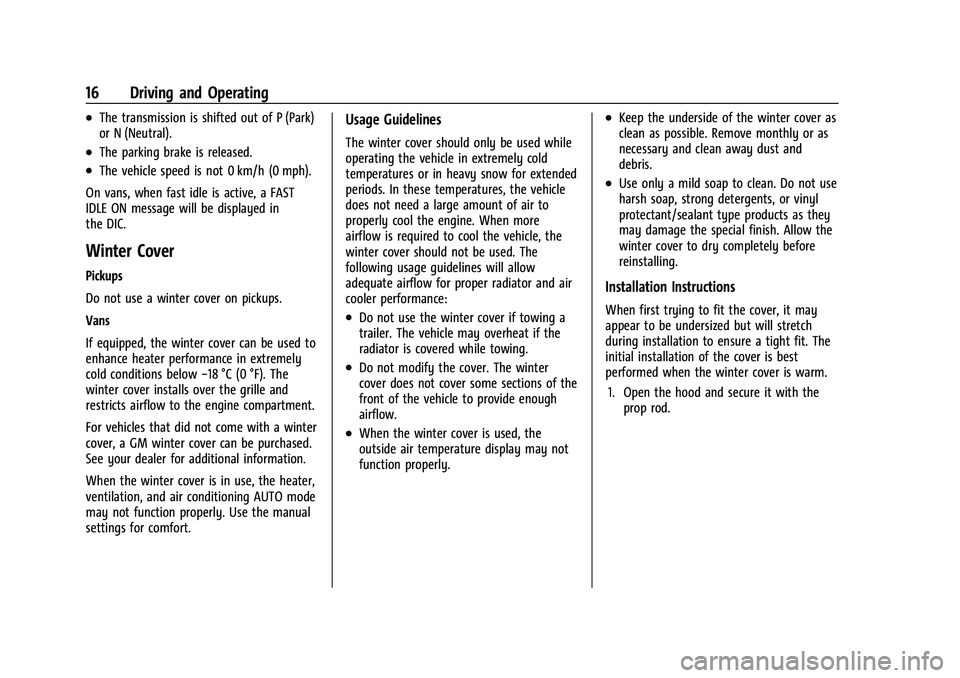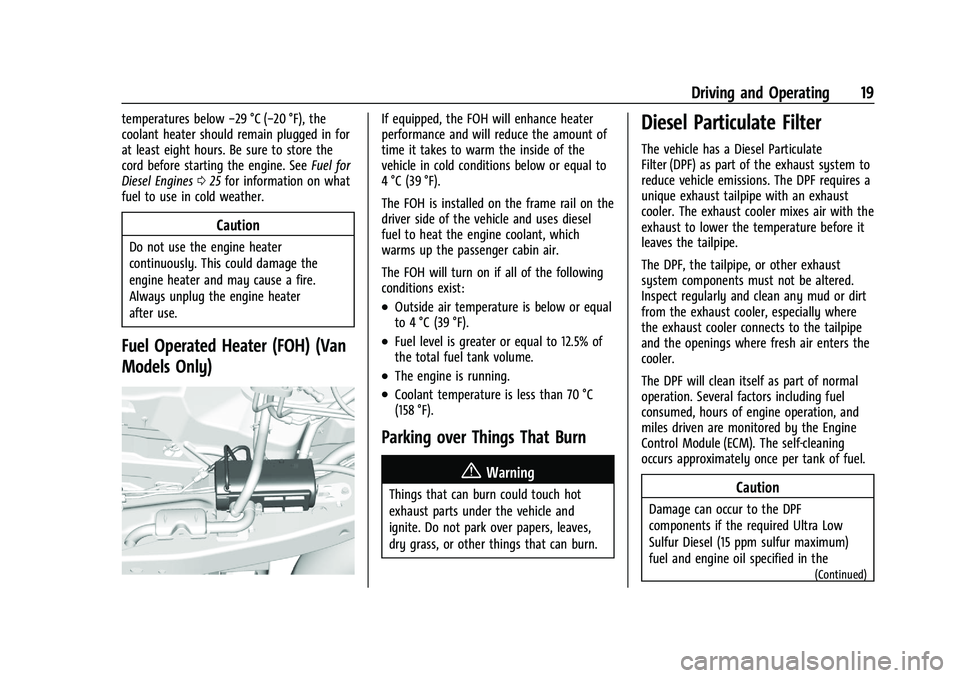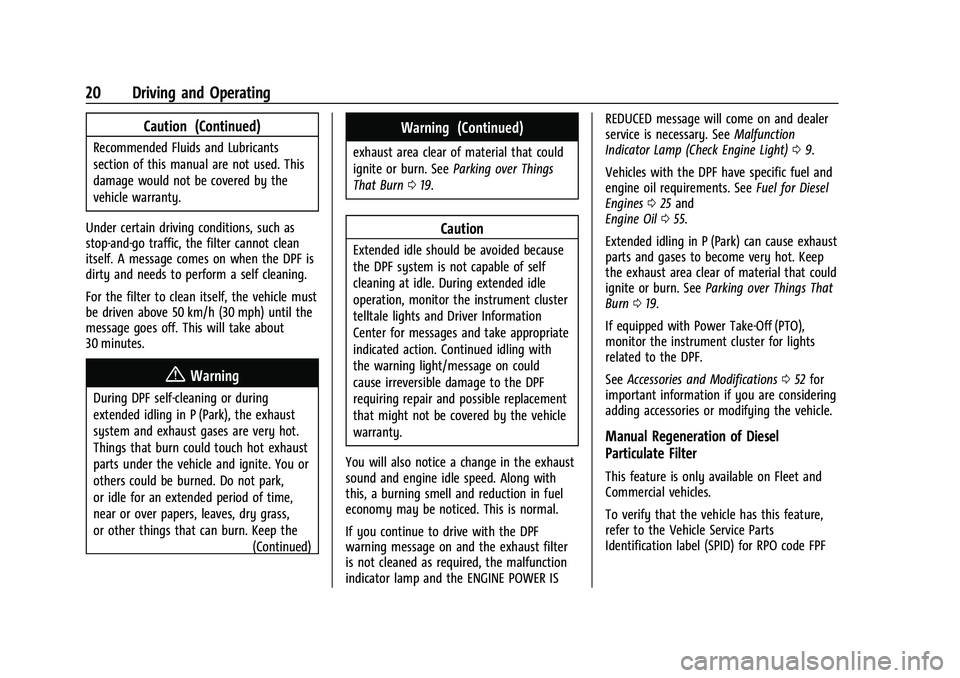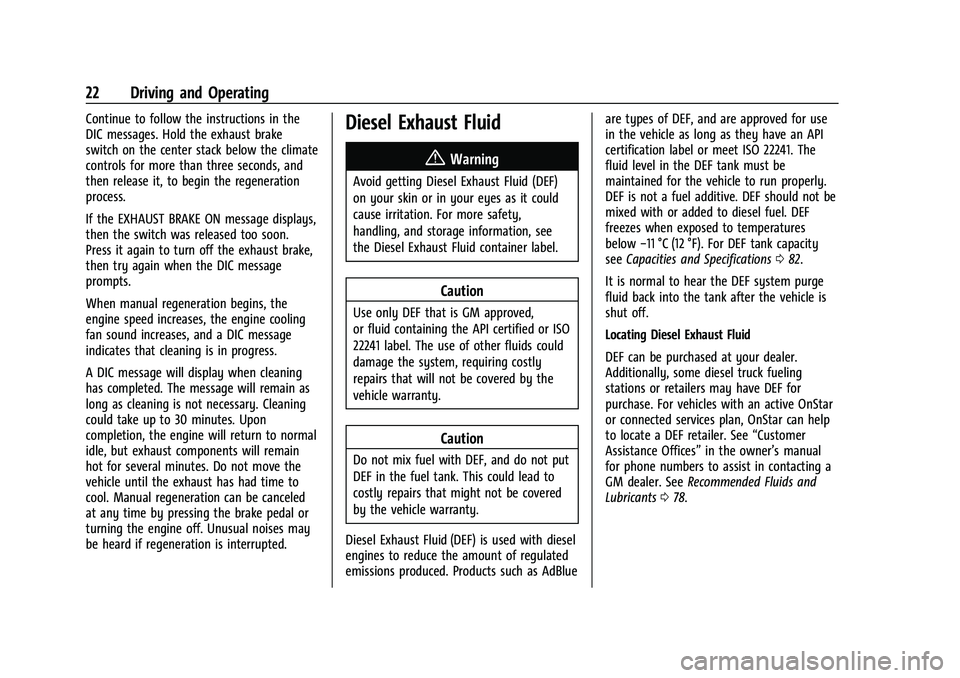Page 17 of 89

Chevrolet/GMC 2.8L Duramax Diesel Engine Supplement (GMNA-Localizing-
U.S./Canada-14465442) - 2021 - CRC - 2/3/20
16 Driving and Operating
.The transmission is shifted out of P (Park)
or N (Neutral).
.The parking brake is released.
.The vehicle speed is not 0 km/h (0 mph).
On vans, when fast idle is active, a FAST
IDLE ON message will be displayed in
the DIC.
Winter Cover
Pickups
Do not use a winter cover on pickups.
Vans
If equipped, the winter cover can be used to
enhance heater performance in extremely
cold conditions below −18 °C (0 °F). The
winter cover installs over the grille and
restricts airflow to the engine compartment.
For vehicles that did not come with a winter
cover, a GM winter cover can be purchased.
See your dealer for additional information.
When the winter cover is in use, the heater,
ventilation, and air conditioning AUTO mode
may not function properly. Use the manual
settings for comfort.
Usage Guidelines
The winter cover should only be used while
operating the vehicle in extremely cold
temperatures or in heavy snow for extended
periods. In these temperatures, the vehicle
does not need a large amount of air to
properly cool the engine. When more
airflow is required to cool the vehicle, the
winter cover should not be used. The
following usage guidelines will allow
adequate airflow for proper radiator and air
cooler performance:
.Do not use the winter cover if towing a
trailer. The vehicle may overheat if the
radiator is covered while towing.
.Do not modify the cover. The winter
cover does not cover some sections of the
front of the vehicle to provide enough
airflow.
.When the winter cover is used, the
outside air temperature display may not
function properly.
.Keep the underside of the winter cover as
clean as possible. Remove monthly or as
necessary and clean away dust and
debris.
.Use only a mild soap to clean. Do not use
harsh soap, strong detergents, or vinyl
protectant/sealant type products as they
may damage the special finish. Allow the
winter cover to dry completely before
reinstalling.
Installation Instructions
When first trying to fit the cover, it may
appear to be undersized but will stretch
during installation to ensure a tight fit. The
initial installation of the cover is best
performed when the winter cover is warm.
1. Open the hood and secure it with the prop rod.
Page 18 of 89
Chevrolet/GMC 2.8L Duramax Diesel Engine Supplement (GMNA-Localizing-
U.S./Canada-14465442) - 2021 - CRC - 2/3/20
Driving and Operating 17
2. Hook the five J-clips to the bottom edgeof the grille.
3. Hook the top center J-clip by the hood latch. 4. Attach the metal hooks, one each at the
top corners.
5. To remove the winter cover, reverse Steps 1–4.
Engine Heater
{Warning
Do not plug in the engine block heater
while the vehicle is parked in a garage or
under a carport. Property damage or
personal injury may result. Always park
the vehicle in a clear open area away
from buildings or structures.
If equipped, the engine heater can provide
easier starting in cold weather conditions at
or below −18 °C (0 °F). The engine heater
should be plugged in at least four hours
before starting.
To Use the Engine Heater
1. Turn off the engine.
Page 19 of 89

Chevrolet/GMC 2.8L Duramax Diesel Engine Supplement (GMNA-Localizing-
U.S./Canada-14465442) - 2021 - CRC - 2/3/20
18 Driving and Operating
Pickups
Vans2. Open the hood and unwrap the electrical
cord. The cord is in the engine
compartment, on the driver side behind
the battery for pickups, and on the
passenger side for vans.
3. Clean and dry the heater cord and connector ends. Check the heater cord
for damage. If it is damaged, do not use
it. See your dealer for a replacement.
Inspect the cord for damage yearly.
4. Plug it into a normal, grounded 110-volt AC outlet.
{Warning
Improper use of the heater cord or an
extension cord can damage the cord and
may result in overheating and fire.
.Plug the cord into a three-prong
electrical utility receptacle that is
protected by a ground fault detection
function. An ungrounded outlet could
cause an electric shock.
.Use a weatherproof, heavy-duty,
15 amp-rated extension cord if needed.
Failure to use the recommended
extension cord in good operating
condition, or using a damaged heater
(Continued)
Warning (Continued)
or extension cord, could make it
overheat and cause a fire, property
damage, electric shock, and injury.
.Do not operate the vehicle with the
heater cord permanently attached to
the vehicle. Possible heater cord and
thermostat damage could occur.
.While in use, do not let the heater
cord touch vehicle parts or sharp
edges. Never close the hood on the
heater cord.
.Before starting the vehicle, unplug the
cord, reattach the cover to the plug,
and securely fasten the cord. Keep the
cord away from any moving parts.
5. Before starting the engine, be sure to unplug and store the cord as it was
before to keep it away from moving
engine parts and prevent damage.
The length of time the heater should remain
plugged in depends on the outside
temperature. You may wish to use the
coolant heater to improve ease of starting
at temperatures between −18 °C (0 °F) and
−29 °C (−20 °F). Keep the coolant heater
plugged in for a minimum of four hours. At
Page 20 of 89

Chevrolet/GMC 2.8L Duramax Diesel Engine Supplement (GMNA-Localizing-
U.S./Canada-14465442) - 2021 - CRC - 2/3/20
Driving and Operating 19
temperatures below−29 °C (−20 °F), the
coolant heater should remain plugged in for
at least eight hours. Be sure to store the
cord before starting the engine. See Fuel for
Diesel Engines 025 for information on what
fuel to use in cold weather.
Caution
Do not use the engine heater
continuously. This could damage the
engine heater and may cause a fire.
Always unplug the engine heater
after use.
Fuel Operated Heater (FOH) (Van
Models Only)
If equipped, the FOH will enhance heater
performance and will reduce the amount of
time it takes to warm the inside of the
vehicle in cold conditions below or equal to
4 °C (39 °F).
The FOH is installed on the frame rail on the
driver side of the vehicle and uses diesel
fuel to heat the engine coolant, which
warms up the passenger cabin air.
The FOH will turn on if all of the following
conditions exist:
.Outside air temperature is below or equal
to 4 °C (39 °F).
.Fuel level is greater or equal to 12.5% of
the total fuel tank volume.
.The engine is running.
.Coolant temperature is less than 70 °C
(158 °F).
Parking over Things That Burn
{Warning
Things that can burn could touch hot
exhaust parts under the vehicle and
ignite. Do not park over papers, leaves,
dry grass, or other things that can burn.
Diesel Particulate Filter
The vehicle has a Diesel Particulate
Filter (DPF) as part of the exhaust system to
reduce vehicle emissions. The DPF requires a
unique exhaust tailpipe with an exhaust
cooler. The exhaust cooler mixes air with the
exhaust to lower the temperature before it
leaves the tailpipe.
The DPF, the tailpipe, or other exhaust
system components must not be altered.
Inspect regularly and clean any mud or dirt
from the exhaust cooler, especially where
the exhaust cooler connects to the tailpipe
and the openings where fresh air enters the
cooler.
The DPF will clean itself as part of normal
operation. Several factors including fuel
consumed, hours of engine operation, and
miles driven are monitored by the Engine
Control Module (ECM). The self-cleaning
occurs approximately once per tank of fuel.
Caution
Damage can occur to the DPF
components if the required Ultra Low
Sulfur Diesel (15 ppm sulfur maximum)
fuel and engine oil specified in the
(Continued)
Page 21 of 89

Chevrolet/GMC 2.8L Duramax Diesel Engine Supplement (GMNA-Localizing-
U.S./Canada-14465442) - 2021 - CRC - 2/3/20
20 Driving and Operating
Caution (Continued)
Recommended Fluids and Lubricants
section of this manual are not used. This
damage would not be covered by the
vehicle warranty.
Under certain driving conditions, such as
stop-and-go traffic, the filter cannot clean
itself. A message comes on when the DPF is
dirty and needs to perform a self cleaning.
For the filter to clean itself, the vehicle must
be driven above 50 km/h (30 mph) until the
message goes off. This will take about
30 minutes.
{Warning
During DPF self-cleaning or during
extended idling in P (Park), the exhaust
system and exhaust gases are very hot.
Things that burn could touch hot exhaust
parts under the vehicle and ignite. You or
others could be burned. Do not park,
or idle for an extended period of time,
near or over papers, leaves, dry grass,
or other things that can burn. Keep the (Continued)
Warning (Continued)
exhaust area clear of material that could
ignite or burn. SeeParking over Things
That Burn 019.
Caution
Extended idle should be avoided because
the DPF system is not capable of self
cleaning at idle. During extended idle
operation, monitor the instrument cluster
telltale lights and Driver Information
Center for messages and take appropriate
indicated action. Continued idling with
the warning light/message on could
cause irreversible damage to the DPF
requiring repair and possible replacement
that might not be covered by the vehicle
warranty.
You will also notice a change in the exhaust
sound and engine idle speed. Along with
this, a burning smell and reduction in fuel
economy may be noticed. This is normal.
If you continue to drive with the DPF
warning message on and the exhaust filter
is not cleaned as required, the malfunction
indicator lamp and the ENGINE POWER IS REDUCED message will come on and dealer
service is necessary. See
Malfunction
Indicator Lamp (Check Engine Light) 09.
Vehicles with the DPF have specific fuel and
engine oil requirements. See Fuel for Diesel
Engines 025 and
Engine Oil 055.
Extended idling in P (Park) can cause exhaust
parts and gases to become very hot. Keep
the exhaust area clear of material that could
ignite or burn. See Parking over Things That
Burn 019.
If equipped with Power Take-Off (PTO),
monitor the instrument cluster for lights
related to the DPF.
See Accessories and Modifications 052 for
important information if you are considering
adding accessories or modifying the vehicle.
Manual Regeneration of Diesel
Particulate Filter
This feature is only available on Fleet and
Commercial vehicles.
To verify that the vehicle has this feature,
refer to the Vehicle Service Parts
Identification label (SPID) for RPO code FPF
Page 22 of 89

Chevrolet/GMC 2.8L Duramax Diesel Engine Supplement (GMNA-Localizing-
U.S./Canada-14465442) - 2021 - CRC - 2/3/20
Driving and Operating 21
or see www.gmupfitter.com to contact the
GM Upfitter Integration Group for
assistance.
If equipped, this feature allows for manual
cleaning/regeneration of the DPF when it is
unable to clean itself. It may be necessary
to perform a manual regeneration if driving
conditions—such as extended slow speed,
stop-and-go traffic, extended idles, short
drive cycles, or stationary PTO operation —
prevent DPF self-cleaning.
Manual regeneration can only be used when
the DPF has become at least 90% full. At
100% full, it will attempt to automatically
self-clean if proper driving conditions are
met. The DPF will clean itself if the vehicle
can be driven above 50 km/h (30 mph) for
about 30 minutes.
A Driver Information Center (DIC) message
displays when manual regeneration is
possible.
Scroll through the DIC pages to find the
Exhaust Cleaning menu. Depending on
whether the vehicle has a base or uplevel
cluster, it may be under the Settings menu.
If the vehicle cannot be stopped when the
DIC message first indicates cleaning is
available, automatic self-cleaning may have begun. If conditions cannot be met for
self-cleaning to complete, and manual
regeneration is selected, it may take up to
four minutes for the system to switch to
manual regeneration. When the switch
occurs, a DIC message prompts to start the
cleaning process.
{Warning
Do not leave the vehicle during the
regeneration.
Make sure that there are no flammables
near the muffler, DPF and exhaust pipe
which may result in a fire.
Remember that the temperature of
exhaust gases is high enough to burn
you. You and others could be seriously
injured.
Before starting the manual regeneration,
make sure all of the following safety
conditions are met:
.The vehicle is parked on level ground,
away from any flammable materials.
.The vehicle is parked outdoors, away
from any walls or buildings.
.The vehicle is at least 3 m (10 ft) from
any obstructions or materials that may
combust or melt.
.The shift lever is in P (Park).
.The fuel tank is at least one-eighth full.
.All fluids are at the proper level.
.No diagnostic trouble codes have been
set, and the malfunction indicator lamp is
not on.
.The engine coolant temperature is above
71 °C (160 °F).
After making sure all of the safety
conditions have been met, press the trip
odometer reset stem or
Von the steering
wheel control for at least one second to
select Start on the infotainment display.
Follow the instructions in the DIC messages.
Touch ACCEPT to acknowledge that all of
these safety conditions have been met and
to activate regeneration.
If the infotainment display returns to the
previous screen, then one or more of the
necessary operating conditions has not been
met. If you cannot determine which
condition has not been met, see
www.gmupfitter.com to contact the GM
Upfitter Integration Group for assistance.
Page 23 of 89

Chevrolet/GMC 2.8L Duramax Diesel Engine Supplement (GMNA-Localizing-
U.S./Canada-14465442) - 2021 - CRC - 2/3/20
22 Driving and Operating
Continue to follow the instructions in the
DIC messages. Hold the exhaust brake
switch on the center stack below the climate
controls for more than three seconds, and
then release it, to begin the regeneration
process.
If the EXHAUST BRAKE ON message displays,
then the switch was released too soon.
Press it again to turn off the exhaust brake,
then try again when the DIC message
prompts.
When manual regeneration begins, the
engine speed increases, the engine cooling
fan sound increases, and a DIC message
indicates that cleaning is in progress.
A DIC message will display when cleaning
has completed. The message will remain as
long as cleaning is not necessary. Cleaning
could take up to 30 minutes. Upon
completion, the engine will return to normal
idle, but exhaust components will remain
hot for several minutes. Do not move the
vehicle until the exhaust has had time to
cool. Manual regeneration can be canceled
at any time by pressing the brake pedal or
turning the engine off. Unusual noises may
be heard if regeneration is interrupted.Diesel Exhaust Fluid{
Warning
Avoid getting Diesel Exhaust Fluid (DEF)
on your skin or in your eyes as it could
cause irritation. For more safety,
handling, and storage information, see
the Diesel Exhaust Fluid container label.
Caution
Use only DEF that is GM approved,
or fluid containing the API certified or ISO
22241 label. The use of other fluids could
damage the system, requiring costly
repairs that will not be covered by the
vehicle warranty.
Caution
Do not mix fuel with DEF, and do not put
DEF in the fuel tank. This could lead to
costly repairs that might not be covered
by the vehicle warranty.
Diesel Exhaust Fluid (DEF) is used with diesel
engines to reduce the amount of regulated
emissions produced. Products such as AdBlue are types of DEF, and are approved for use
in the vehicle as long as they have an API
certification label or meet ISO 22241. The
fluid level in the DEF tank must be
maintained for the vehicle to run properly.
DEF is not a fuel additive. DEF should not be
mixed with or added to diesel fuel. DEF
freezes when exposed to temperatures
below
−11 °C (12 °F). For DEF tank capacity
see Capacities and Specifications 082.
It is normal to hear the DEF system purge
fluid back into the tank after the vehicle is
shut off.
Locating Diesel Exhaust Fluid
DEF can be purchased at your dealer.
Additionally, some diesel truck fueling
stations or retailers may have DEF for
purchase. For vehicles with an active OnStar
or connected services plan, OnStar can help
to locate a DEF retailer. See “Customer
Assistance Offices” in the owner’s manual
for phone numbers to assist in contacting a
GM dealer. See Recommended Fluids and
Lubricants 078.
Page 24 of 89

Chevrolet/GMC 2.8L Duramax Diesel Engine Supplement (GMNA-Localizing-
U.S./Canada-14465442) - 2021 - CRC - 2/3/20
Driving and Operating 23
Filling the DEF Tank
DEF Fill–Van Model Shown, 4-Cylinder
Pickups Similar
The blue DEF cap is behind the fuel/DEF
door. Do not remove the fuel and DEF caps
at the same time. Fill diesel fuel and DEF
independently. Turn the DEF cap
counterclockwise to remove.
In cold conditions DEF can freeze in the DEF
fill pipe opening. If this prevents the filling
of the DEF tank, place the vehicle in a warm
garage overnight.
Fill the DEF tank on level ground and with
the vehicle off. When adding DEF, it is
recommended to fully fill the DEF tank. For DEF tank capacity see
Capacities and
Specifications 082. When adding DEF to an
empty or very low tank, always add at least
7.5L (2 gal) of fluid to release the vehicle
from speed limitation.
When fluid reaches the top of the DEF fill
pipe, stop filling. Do not top off the DEF
tank. If using a bottle or jug to refill DEF,
follow the instructions on the container
label and use a dedicated fill aid.
Caution
Do not overfill the DEF tank and do not
allow DEF to contact the finished surfaces
of the vehicle, as it could damage the
vehicle finish. If DEF is spilled during
filling, wipe any affected surface with a
damp cloth.
Make sure the cap is fully installed.
Push the fuel/DEF door closed.
DEF Low
As the DEF level drops, warnings will
automatically be displayed in the Driver
Information Center (DIC). Select Vehicle
Information in the DIC to view DEF level
status. See Driver Information Center (DIC)
0 10. Refill the DEF tank at the first opportunity
after a low warning indication to avoid
vehicle speed limitations.
It may take some time for the vehicle to
detect that DEF has been added. If there
was a vehicle speed limitation, it will be
removed gradually and it may take several
kilometers/miles for the DIC message to
update.
If DEF is added under freezing conditions,
especially if DEF level is low and frozen, up
to several hours of drive time may be
required to remove the speed limitation.
It is recommended to ensure the DEF tank
level is 30% or higher during winter time.
The DEF range DIC message first displays at
approximately 1 600 km (1,000 mi). This
message appears again at approximately
500 km (300 mi) of remaining range before
the exhaust fluid tank becomes empty.
As the fluid level nears empty, these
messages appear every time the vehicle is
started.
If the DEF low warnings are ignored and the
DEF tank becomes empty, the DIC will
display messages that describe the action
needed and distance until vehicle speed is